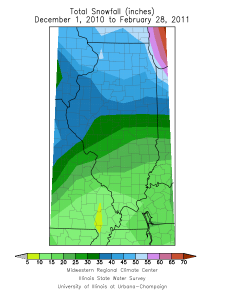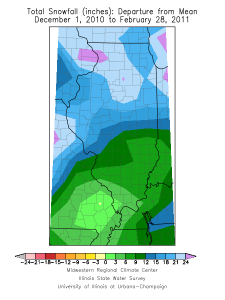For anyone who lives in Illinois, it will come as no surprise that we were colder and snowier than normal this winter. The statewide average temperature for December-February was 24.9 degrees. That is 3.3 degrees below normal and the 17th coldest December-February since statewide record began in 1895. The coldest December-February in Illinois was 1977-78 with 19.6 degrees.
Snowfall for December-February ranged from 15 inches in southern Illinois to over 45 inches in northern Illinois (see maps below). According to the Lincoln NWS office, Peoria reported its snowiest December-February on record with 52.5 inches while Springfield reported its fifth snowiest December-February with 34.2 inches. According to the Chicago NWS office, Rockford reported its third snowiest December-February with 51.2 inches and Chicago reported its fifth snowiest December-February with 56.3 inches.
Precipitation (both rainfall and the water content of any snow) was near-normal. The statewide average precipitation was 6.90 inches, only 0.14 inches below normal.
Climatologists define winter as the months of December, January, and February because it lines up better with the kinds of weather we expect to see in winter. It’s better than the December 22 to March 22 definition, which is based on the winter solstice and the vernal equinox. In many cases in Illinois, we have already had several doses of winter weather by December 22 and winter weather is fading away once March arrives.


Winter Outlook for Illinois – Wetter and Warmer
NOAA’s Climate Prediction Center released their official winter outlook today. The major influence in this winter’s weather will be the moderate to strong La Niña event occurring in the Pacific Ocean.
Precipitation
The winter outlook calls for an increased chance of above-normal precipitation across Illinois. They also state that the Ohio River Valley (including Illinois) is … “likely to see increased storminess and flooding.” Other studies have shown an increase in snowfall in the Great Lakes region during past La Niña events, especially in the January-March period.
Temperature
The southern two-thirds of the state has an increased chance of above-normal temperature. Meanwhile the northern third of Illinois has “equal chances” of above-, below-, or normal temperatures. This basically means that their forecast tools are providing no guidance on winter temperatures in northern Illinois, including the Chicago area.



